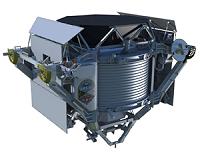 |
Pasadena CA (JPL) May 20, 2011 A five-year survey of 200,000 galaxies, stretching back seven billion years in cosmic time, has led to one of the best independent confirmations that dark energy is driving our universe apart at accelerating speeds. The survey used data from NASA's space- based Galaxy Evolution Explorer and the Anglo-Australian Telescope on Siding Spring Mountain in Australia. The findings offer new support for the favored theory of how dark energy works - as a constant force, uniformly affecting the universe and propelling its runaway expansion. They contradict an alternate theory, where gravity, not dark energy, is the force pushing space apart. According to this alternate theory, with which the new survey results are not consistent, Albert Einstein's concept of gravity is wrong, and gravity becomes repulsive instead of attractive when acting at great distances. "The action of dark energy is as if you threw a ball up in the air, and it kept speeding upward into the sky faster and faster," said Chris Blake of the Swinburne University of Technology in Melbourne, Australia. Blake is lead author of two papers describing the results that appeared in recent issues of the Monthly Notices of the Royal Astronomical Society. "The results tell us that dark energy is a cosmological constant, as Einstein proposed. If gravity were the culprit, then we wouldn't be seeing these constant effects of dark energy throughout time." Dark energy is thought to dominate our universe, making up about 74 percent of it. Dark matter, a slightly less mysterious substance, accounts for 22 percent. So-called normal matter, anything with atoms, or the stuff that makes up living creatures, planets and stars, is only approximately four percent of the cosmos. The idea of dark energy was proposed during the previous decade, based on studies of distant exploding stars called supernovae. Supernovae emit constant, measurable light, making them so- called "standard candles," which allows calculation of their distance from Earth. Observations revealed dark energy was flinging the objects out at accelerating speeds. Dark energy is in a tug-of-war contest with gravity. In the early universe, gravity took the lead, dominating dark energy. At about 8 billion years after the Big Bang, as space expanded and matter became diluted, gravitational attractions weakened and dark energy gained the upper hand. Billions of years from now, dark energy will be even more dominant. Astronomers predict our universe will be a cosmic wasteland, with galaxies spread apart so far that any intelligent beings living inside them wouldn't be able to see other galaxies. The new survey provides two separate methods for independently checking the supernovae results. This is the first time astronomers performed these checks across the whole cosmic timespan dominated by dark energy. The team began by assembling the largest three- dimensional map of galaxies in the distant universe, spotted by the Galaxy Evolution Explorer. The ultraviolet-sensing telescope has scanned about three-quarters of the sky, observing hundreds of millions of galaxies. "The Galaxy Evolution Explorer helped identify bright, young galaxies, which are ideal for this type of study," said Christopher Martin, principal investigator for the mission at the California Institute of Technology in Pasadena. "It provided the scaffolding for this enormous 3-D map." The astronomers acquired detailed information about the light for each galaxy using the Anglo- Australian Telescope and studied the pattern of distance between them. Sound waves from the very early universe left imprints in the patterns of galaxies, causing pairs of galaxies to be separated by approximately 500 million light-years. This "standard ruler" was used to determine the distance from the galaxy pairs to Earth - the closer a galaxy pair is to us, the farther apart the galaxies will appear from each other on the sky. As with the supernovae studies, this distance data were combined with information about the speeds at which the pairs are moving away from us, revealing, yet again, the fabric of space is stretching apart faster and faster. The team also used the galaxy map to study how clusters of galaxies grow over time like cities, eventually containing many thousands of galaxies. The clusters attract new galaxies through gravity, but dark energy tugs the clusters apart. It slows down the process, allowing scientists to measure dark energy's repulsive force. "Observations by astronomers over the last 15 years have produced one of the most startling discoveries in physical science; the expansion of the universe, triggered by the Big Bang, is speeding up," said Jon Morse, astrophysics division director at NASA Headquarters in Washington. "Using entirely independent methods, data from the Galaxy Evolution Explorer have helped increase our confidence in the existence of dark energy."
Share This Article With Planet Earth
Related Links Galaxy Evolution Explorer at CaltechGalaxy Evolution Explorer at NASA Stellar Chemistry, The Universe And All Within It
 Searching for dark matter and antimatter
Searching for dark matter and antimatterBonn, Germany (SPX) Apr 27, 2011 The Alpha Magnetic Spectrometer (AMS) will be located outside the International Space Station (ISS) and will use its various detectors to seek cosmic radiation in space. On 29 April 2011, at 21:47 CET (19:47 UTC), the AMS will be launched on board the space shuttle Endeavour from Cape Canaveral (Florida), en route to the ISS. The project, supported by the German Aerospace Center, will invo ... read more |
|
| The content herein, unless otherwise known to be public domain, are Copyright 1995-2010 - SpaceDaily. AFP and UPI Wire Stories are copyright Agence France-Presse and United Press International. ESA Portal Reports are copyright European Space Agency. All NASA sourced material is public domain. Additional copyrights may apply in whole or part to other bona fide parties. Advertising does not imply endorsement,agreement or approval of any opinions, statements or information provided by SpaceDaily on any Web page published or hosted by SpaceDaily. Privacy Statement |